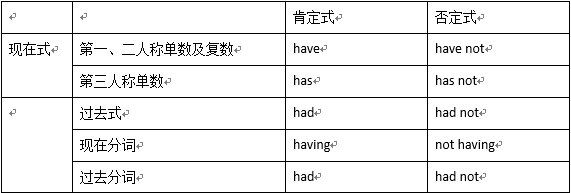have是助动词吗
have是助动词吗
Have是助动词,其基本用法有:与过去分词构成各种完成时态;与been+现在分词构成各种完成进行时态;构成have got词组。
 这是口语中常用的have的形式;构成have to结构;构成had better,had best,had rather等词组。
这是口语中常用的have的形式;构成have to结构;构成had better,had best,had rather等词组。
一、have的形式

二、have的基本用法 1、与过去分词构成各种完成时态。例如: I’ve seen this movie. 我看过这部电影。 Kenny had not kept the door locked; there had been no need. 肯尼没有锁门,因为没有必要锁门。
2、与been+现在分词构成各种完成进行时态。例如: I’ve been dancing all morning. 整个上午我都在跳舞。 Li Yan had been working for the Company for seven years。 李岩一直在这家公司上班,已经有七年了。
3、构成have got词组,这是口语中常用的have的形式。例如: I have got two sisters. 我有两个姐姐。
4、构成have to结构。 1)have to与must意义相近,但must没有“时”的不同形式,have to有“时”的各种形式(had to,have / has / had had to),并能与一些助动词(shall / should,will / would, may / might等)连用。例如: I have to / must leave now. 现在我一定得走了。 I didn’t catch the last bus last night, so I had to walk home. 昨夜我没赶上末班车,所以不得不走回家。 2)have to 的疑问式和否定式是do+主语+have to…?和do+not have to…。也可用 have +主语+ to…?和have not to的形式。例如: Do you have to go now? 或 Have you to go now? 你现在一定得走吗? Mike doesn’t have to be here.或 Mike hasn’t to be here. 麦克无须呆在这儿。
5、构成had better,had best等词组。 had better 和had best 是“最好还是……”或“还是……好”的意思。在had better中,had不表示过去时间,不能用have或has代替。had better后可接不带to 的不定式或接进行式、完成式或被动语态。例如: You’d better not leave the dormitory. 你最好不要离开宿舍。 You had better hope Jim makes it back. 你最好祈祷吉姆能平安归来。
注意: have在表示“有”、“吃”等意思还可分别用作使役动词和实义动词。例如: They have had the problem solved. 他们现在已把这个问题让其他人解决了。(使役动词) Bad news has wings. 丑事传千里。(实义动词)
